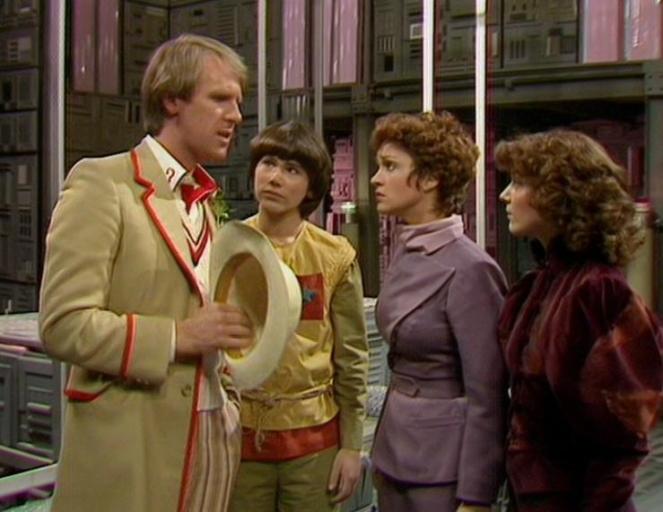
Some “classic” Doctor Who stories have not dated well. Some remain very good. One is Four to Doomsday (January 1982), which I’ve just re-watched. It’s the first Fifth Doctor — Peter Davison — story filmed, though not the first screened (that was Castrovalva, which is not as good).
Davison took a break from playing Tristan Farnon in All Creatures Great and Small to play the Doctor for three years, afterwards returning to the Yorkshire Dales. He played the Time Lord as a boyish, cricket-loving Englishman (!) much like the Tristan character. He was recruited by long-time Who producer John Nathan-Turner, who’d also worked on All Creatures.
It’s a dramatic story with good acting and very good sets and special effects for the time, when Doctor Who was hilariously noted for cardboard props as alien worlds and flying kettles as space ships, such was its low budget from its 1963 start till its 1989 hiatus. In the story, the Tardis lands in a gigantic Earth-bound craft controlled by the Monarch of Urbanka (played by Stratford Johns of Z Cars and Softly Softly fame), who intends to take over our planet after he had mined and polluted his own to destruction.
The latter was a Global Warming plot reference six years before Nasa’s James Hansen created this still very current “we’re all doomed” scenario. The story cites an ozone hole (the Antarctic one was of big concern in 1982) on Monarch’s home planet as the final cause of Urbanka’s ruin, burning it to cinders.
Aboard the Monarch’s ship are four people, at first sight apparently humans kidnapped by Monarch during past visits to Earth over thousands of years—ancient Greek philosopher Bigon; Chinese Mandarin Lin Futu; Mayan princess Villagra; and Kurkutji, an Australian Aborigine.
The latter was played by Ilario Bisi-Pedro, who appears to have been a Black British actor about whom little information exists. Though the part was sympathetically portrayed, I doubt a non-Aborigine would be allowed to play one today without an uproar. At the time, the BBC was actively promoting Doctor Who‘s popularity in Australia, with the Davison era featuring Australian actress Janet Field as one of the Doctor’s companions, air hostess Tegan, she of the execrable accent no dinkum Aussie would speak.
As the story develops, it is revealed that the four kidnapped humans and others like them are really androids whose human memories have been implanted in silicon chips. Monarch and his Urbankan companions Enlightenment (Annie Lambert) and Persuasion (Paul Shelley) refer to Urbanka’s pre-android era as “the flesh times,” with distaste, hence their plan to quickly poison Earth’s population, before mining our planet’s resources, too.
Monarch’s mining scheme is designed to amass the energy to build a spacecraft capable of travelling faster than light, to enable him to go back in time to before the Big Bang that created our universe, where he expects to meet himself, whom be believes is God. It is a fascinating concept and I am surprised no Doctor Who story has actually been set before time began, or featured a meeting between the Doctor and Jesus, for example.
After all, in the 2006 story The Satan Pit, the Tenth Doctor (David Tennant) meets the Devil. Einstein’s Relativity theories (drawn on in Four to Doomsday, and this year’s World Enough and Time and The Doctor Falls) allow time travel, so it’s not an impossible scenario.

Footnotes:
I’ve lately been re-watching All Creatures Great and Small on DVD too, and the resemblance between Davison’s Tristan and Doctor characters is palpably obvious and deliberate, no doubt to maintain the Tristan character’s popularity at a time that Fourth Doctor Tom Baker was replaced by Davison after seven years which had entrenched Baker as the doctor for many viewers.
Davison’s daughter Georgia is married to David Tennant, who was most recently seen on our screens in Broadchurch, which also starred Jodie Whittaker, recently cast as the Thirteenth Doctor.
